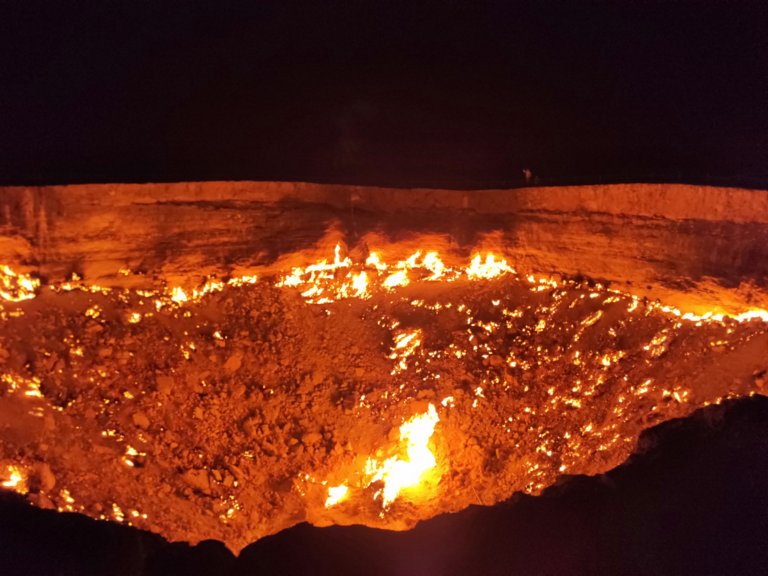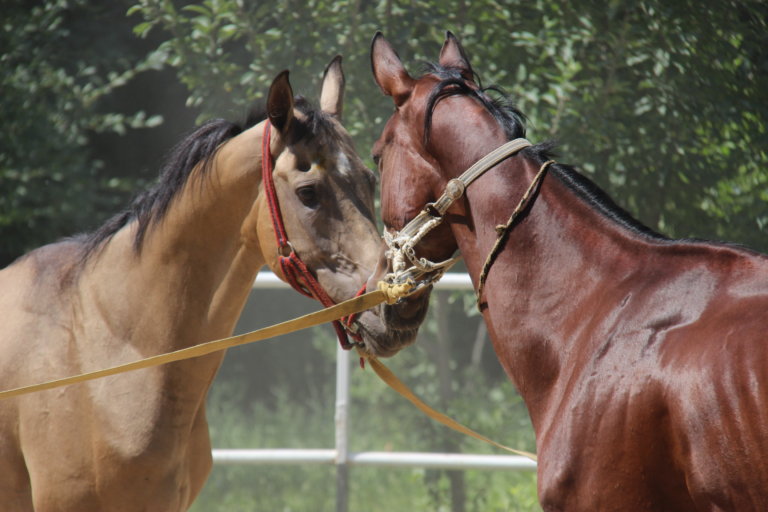Ashgabat, Turkmenistan. Day 45 June 13th 2019
White marble – and more white marble. Blue sky. Massive monuments. Complex History. There you have the incredible Ashgabat.
Ashgabat Turkmenistan – Fascinating and compelling – where to begin in this huge modern city, in a nation with an ancient history. The country with an important past as a crossroad for may of the Silk Road routes.
We began at the museum – Let’s get an overview of the history we thought.
This museum is an unbelievable history of the region from the early Stone Age to Independence in 1991. There are apparently over 300,000 exhibits. We toured with a Docent to give us the highlights, history and overview and still we left wanting more but trying to process what we had seen and learned.
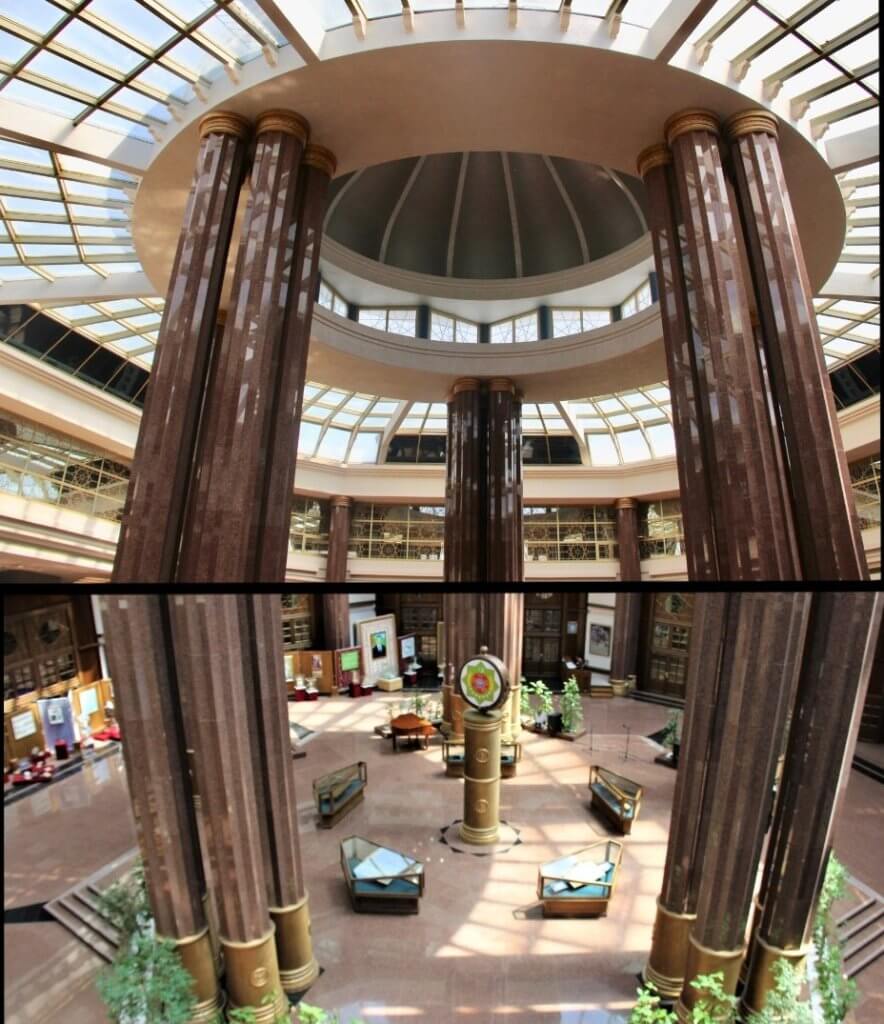
Extensive information on yet another complex history that included – a period under Alexander the Great, the Seljuk empire, the Arab empire, Ghengis Khan, complex tribal rule, unification and independence, The President – and more of course.
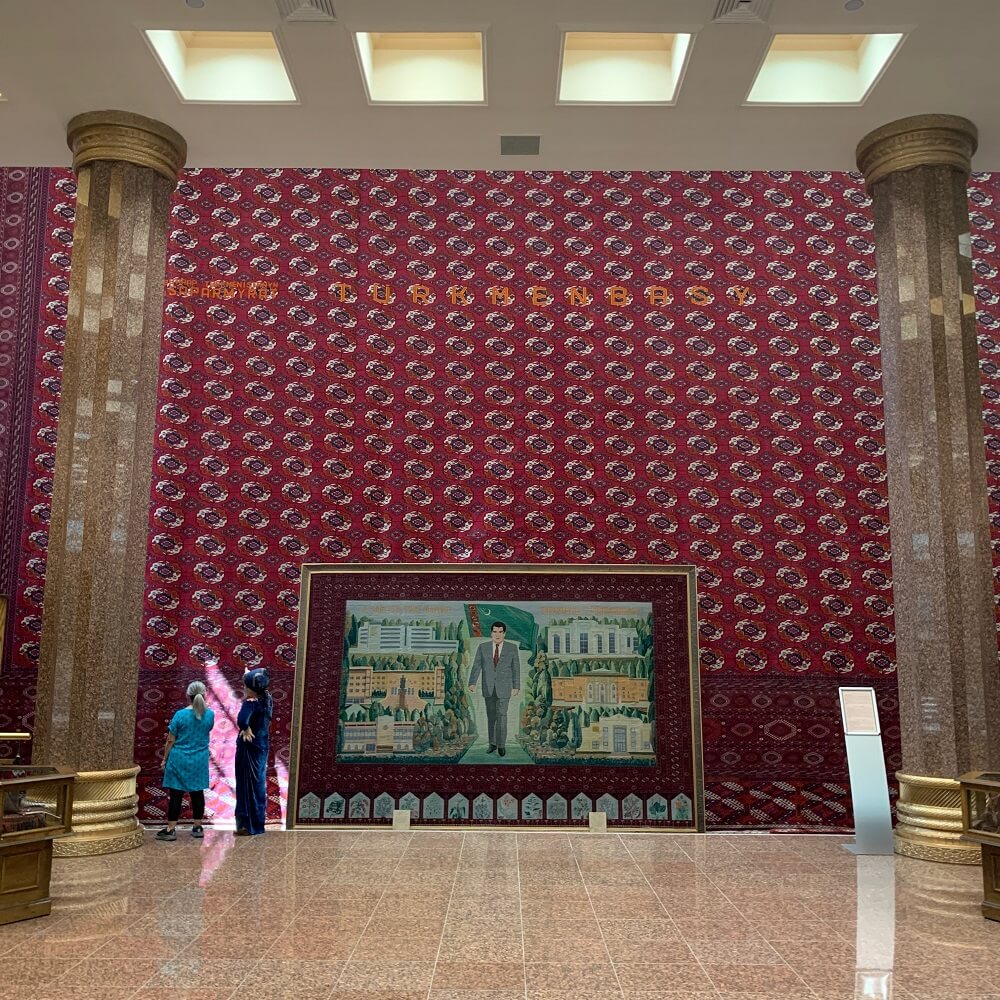
A carpet exhibition complete with second largest handwoven carpet in the world – the first and Guinness book of records carpet is also in Ashgabat in the Carpet Museum. A double-sided carpet showing a lineage of the famous Sky Horses.
Rhytons – a drinking vessel and also thought to be used for wine to be delivered over fire as a sacrifice. These were carved from ivory and often had a story carved around the top and a figure sculpted on the point with a small outlet hole.
This collection of 1500-year-old Rhytons were found in 1948 and while some have been removed to Russia and other museums a collection remain in Turkmenistan.
Ossuaries from Zoriatrian times that appeared to have Hellenic figures carved on the outside.

An exquisite fertility ornament with a figure holding stalks of wheat with stalks around the body.
Relics from major excavations around Turkmenistan – of which there are many. Not surprising when you look at a map of the country and see the crisscrossing and crossroads of the Silk Roads. So many sites they can not all be excavated.

At Margush and surrounding major settlements, the early history of Zoroastrianism has been discovered. The museum has many exhibits relating to Zoroastrianism including a range of Ossuaries. Finds across era include the Paleolith, Mesolith, Neolith and Eonolith eras reinforcing the ancient civilisations living in the area of Turkmenistan.
Finds reinforce that this area has always been a crossroads – a meeting point for many civilisations. Evidence found all over Turkmenistan includes:
- Altyn Dep – a Bronze age 5th to 2nd century BC.
- New and Old Nesa
- The time of Alexander the Great
- Seljuk empire
- Parthia
- Gurganj
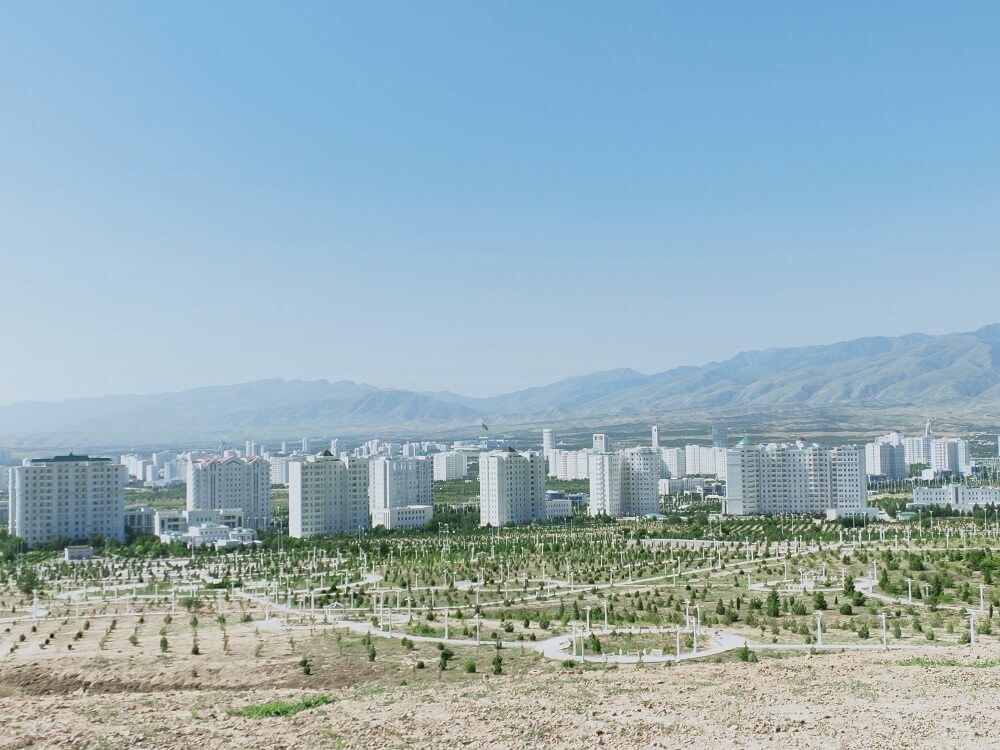
Emerging with cognitive overload after another complex history lesson it was a relief to leave ancient history, sit back, and see modern Ashgabat. A city I had been looking forward to having heard about so much about it:
- The largest amount of white marble buildings in the world.
- The largest enclosed Ferris wheel in the world.
- A Government Ministry of Horses.
- A Dental Centre shaped like a tooth, an airport shaped like a bird.
- An eye hospital shaped like an eye.
- A “Happiness Palace” where all weddings take place.
- A public library that looks like an ancient Hellenic palace.
- An Olympic Stadium with its own monorail around the circumference.
- All cars in the city should be Silver or Grey and clean.
And so we saw:
The Dental Centre – a building in the shape of a tooth
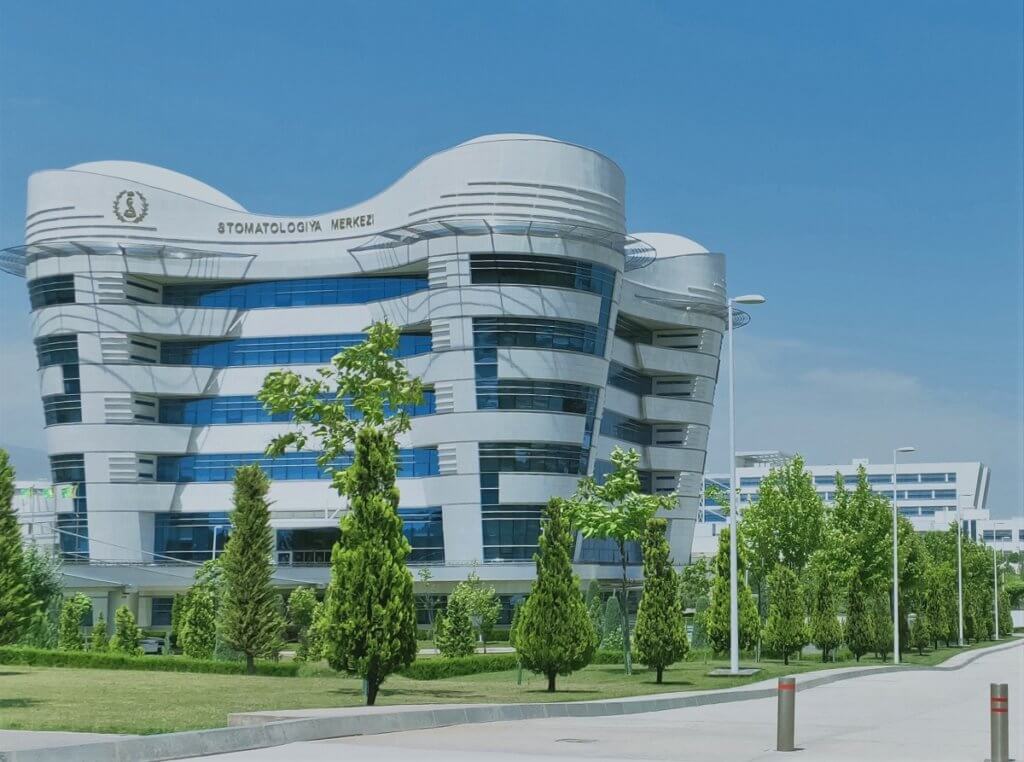
A building nick-named Happiness Palace being the spot all weddings (and apparently divorces) take place.
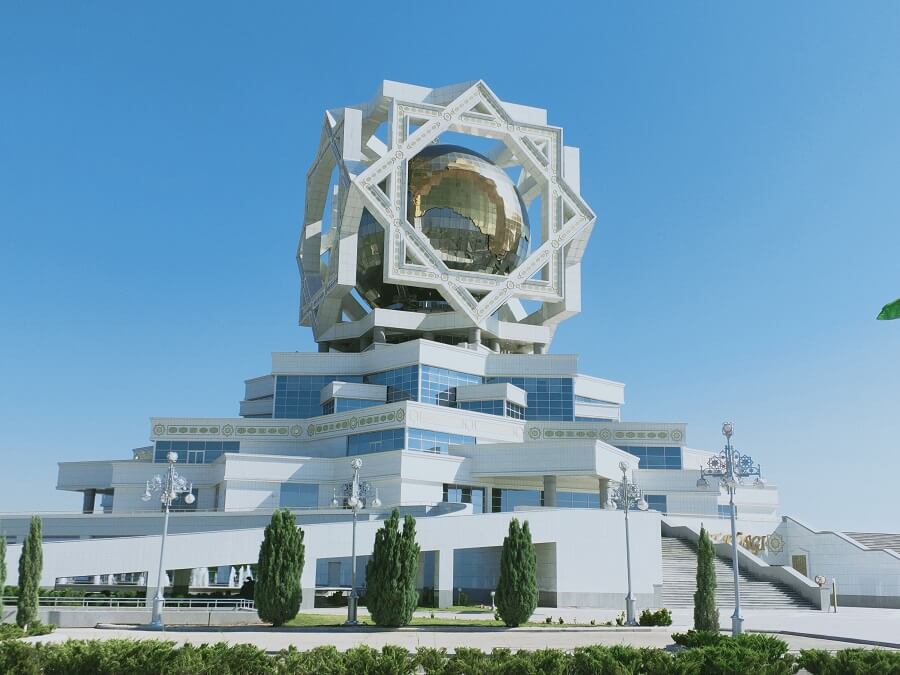
The largest indoor Ferris Wheel in the World entered in the Guinness Book of World Records

It was all this and more – an excess of huge, of white, of water fountains, of massive monuments. All conspiring to make one feel you are living in an earlier Hellenic empire. Add blue skies and a minimal number of cars on the wide roads and the feeling of expansive good will abounds.
To further unite the nation modern unifying emblems are used throughout the city – the 8 point star and the 5 carpet emblems of each region.
Ashgabat region (south) – symbols of bird footprints
Balkan region (Caspian sea) – anchors and boats
Mary (south-east) –cotton, a major crop of the region
Lebub region (north-east) – flowers. Near the head of the river and a green paradise.
Dasoguz region (north-west) – 2 chickens (now looks like an H) depicting the bird life of the area

Huge and I mean HUGE commemorative monuments abound throughout the city. Set in lush surrounds with water and gardens galore they encourage families and community to visit and stay awhile. In addition to an huge gold monument of the first President there is also:
Monument to Independence – gained from the Soviet Union in 1991
Monument of Neutrality – in 1995 Turkmenistan became the only country in the world to be officially recognised as Neutral by the United Nations. The vote in favour was apparently 184 countries. The base of the monument is a tripod signifying the traditional communal cooking method over a fire. Strength of the people and the coming together of tribes and peoples.

In the museum, we had seen the gift of a highly decorated silver and gold sword in a sheath – a sword which cannot be removed from the sheath to signify neutrality.
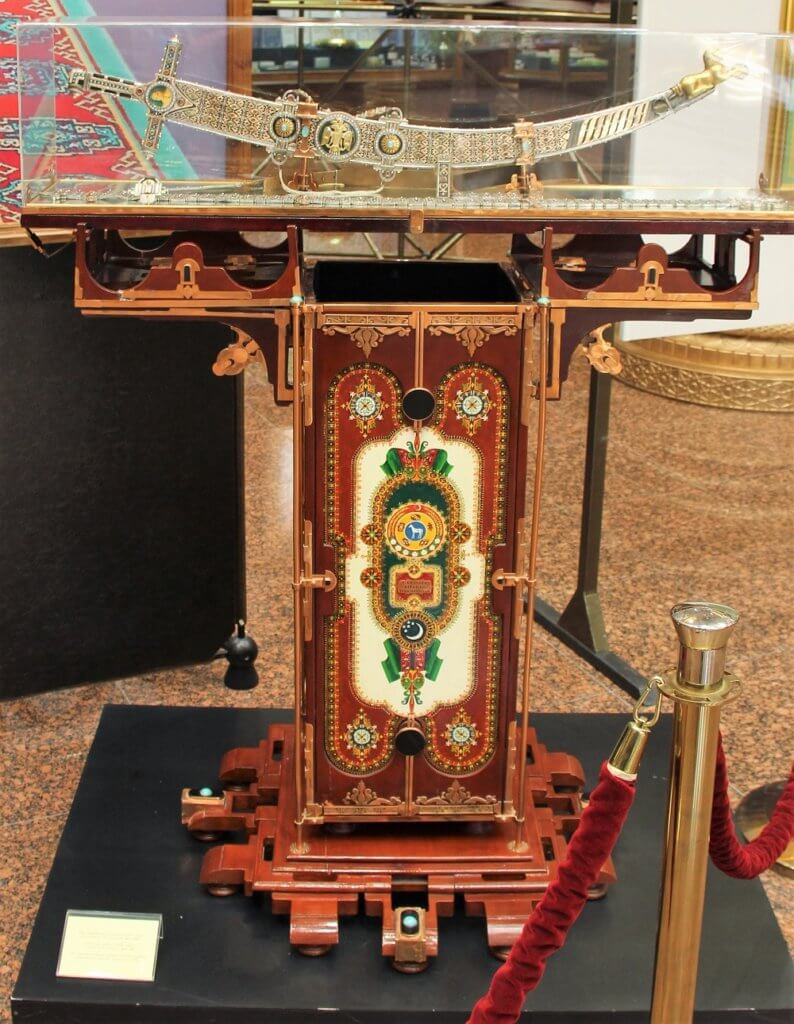
Hakydasy Memorial Park – a huge commemoration of the wars with the eternal flame burning between 5 huge granite pillars. The surrounding park and massive wall plaques commemorating many of the wars Turkmenistan has been involved in. The mindblowing sizes are something like a park of 60 acres. a memorial of 3,000 feet long.
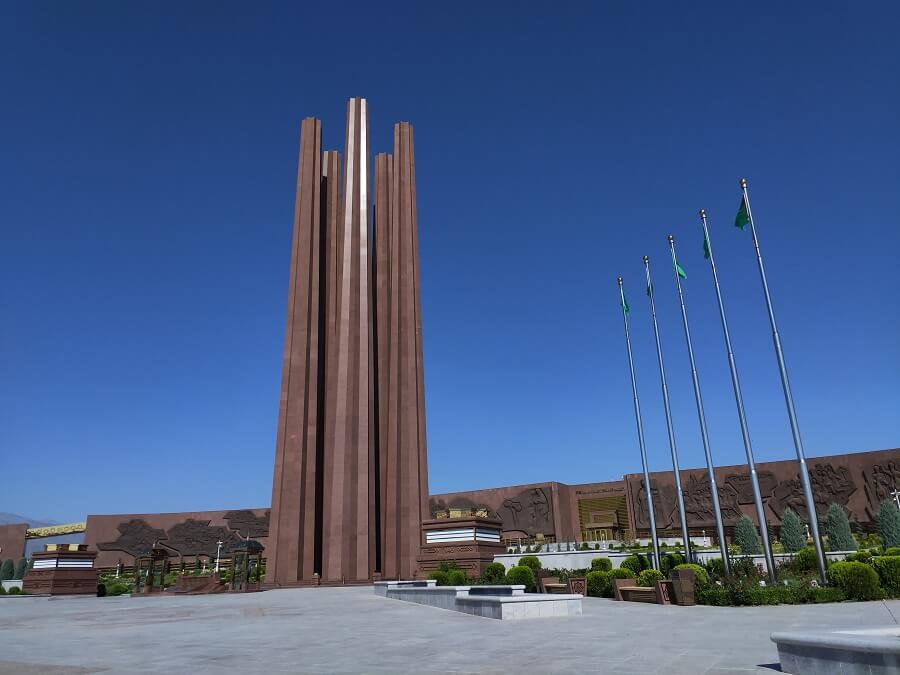
Memorial to the Earthquake of 1948 – a huge bull holding the earth – showing Turkmenistan – in between its horns. Atop the globe a woman holding up a golden baby. Myth has it that the bull holds the earth and shaking it horns creates the earthquake. The golden baby symbolising new start – or the birth of the new president.
The severe earthquake killed 70,000 people and destroyed 90% of the buildings. Rebuilding was aided by people and skills from all over the then Soviet Union.

At the end of all this, our minds and eyes were popping. Time for late lunch in a Melbourne style café Sa Kofe complete with a quiet and comfortable place to sit, coffee and a wide-ranging menu. Today went for international instead of local and opted for Haloumi Salad with crisp and salty Haloumi over a fresh salad.
We also discovered the confusing nature of buildings when they are not signed and have a similar look. Yesterday looking for the cafe Anna had recommended we found as described – in the park, a white marble building, with brown windows and it was a cafe. Simple, nice but not quite what we thought we were heading to – it was where we bumped into two other travellers we had met at Darvaza. The only 4 people in the cafe. So today we get taken to the searched-for cafe and while only a few steps from the other it is completely different- bustling, busy, and great coffee.
PHOTOS OF OUR TIME IN TURKMENISTAN
[contact-form][contact-field label=”Name” type=”name” required=”true” /][contact-field label=”Email” type=”email” required=”true” /][contact-field label=”Website” type=”url” /][contact-field label=”Message” type=”textarea” /][/contact-form]

